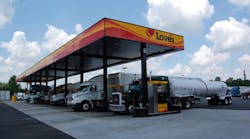There are other factors, too, that may affect America’s chance at energy independence: intensification of efforts aimed at limiting and even stopping fracking, which is increasingly how the lion’s share of our natural gas reserves are being developed; efforts by the Environmental Protection Agency (EPA) to tighten power plant emissions, which impacts the ability to use coal to generate electricity (though the Supreme Court recently put limits on that regulatory push); plus concerns that natural gas, often seen as a low-cost alternative to diesel fuel, may undergo a major price spike later this year.
It doesn’t help, either, that another ripple effect form the growing unrest in Iraq is higher fuel prices here in the U.S., though it is worthy of note that the Obama administration recently lifted a four-decade ban on the exports of unrefined American crude oil.
Despite all of that, however, more and more energy executives still think the U.S. can attain energy independence within the next 15 years, eliminating the U.S. dependency for foreign energy sources. That’s according to findings from the 12th annual Energy Industry Outlook Survey conducted by the KPMG Global Energy Institute.
[On top of that, the firm’s own analysis – contained within its Outlook 2014 paper – believes U.S. independence is “on the horizon” by 2020 at the earliest.]
KPMG's annual energy survey, which polled more than 100 senior U.S. executives working for global energy companies, found that nearly three-quarters (73%) believe the U.S. can attain energy independence by 2030, or sooner – up 10 percentage points from KPMG's 2013 survey. Of those 73%, some 17% believe the U.S. could fully meet current energy demand with only U.S.-based sources by 2020.
Other than the continued development of conventional and unconventional domestic energy reserves, the KPMG survey found that 37% of executives cite the development of energy transportation infrastructure such as pipelines and transmission lines as the most important action they believe the U.S. should take to attain energy independence. Another 23% cite greater use of renewable energy sources and 20% point to greater use of alternative fuels for transportation, including natural gas, electricity and biodiesel."Technology continues to offer the promise of a greener, safer, cheaper and more reliable energy future [and] exciting new breakthroughs are leading to a whole new generation of domestic oil and gas production, particularly from deep-water, oil sands, and shale assets," noted John Kunasek (at left) KPMG’s national sector leader for energy and natural resources.
"These developments are contributing to a significant transformation of the energy industry, adding to the increased optimism among energy executives on the potential for U.S. energy independence and the overall future of the energy industry," he added.
KPMG also found that 70% of the executives in its poll expect the U.S. economy will significantly or moderately improve within the next year – a 29% increase from 2013 – while 55% expect U.S. headcount to increase by 1% to 10%, which is a 17% increase over 2013.
The energy executives surveyed by KPMG also appear confident that oil and gas pricing will remain relatively stable for 2014. One quarter of respondents are bullish that the average price (per MMBtu or one million British Thermal Units) of natural gas will fall in the range between $3.00 and $3.75, while another 47% say between $3.76 and $4.50.Additionally, 44% percent of survey respondents expect the average price (dollar per barrel) of Brent Crude oil for 2014 to fall into the $106-$111 range, with another 38% expecting $100-$105 range, and 6% expecting $99 or lower.
"Natural gas production in the U.S., and its reputation as a low-cost alternative to other energy sources, is shifting the future of the energy industry," noted Regina Mayor (at right), KPMG’s advisory industry leader for energy and natural resources.
"Additionally, shale is quickly shifting from 'the next big thing' to an essential part of the global energy sector, and while the U.S. is still ahead in terms of commercializing this valuable asset, a series of discoveries and technological advances is opening up the playing field to new markets around the globe,” she pointed out.
Yet despite an overall optimistic outlook, Mayor added that respondents to KPMG’s annual poll most frequently cite energy prices (40%), the regulatory environment (31%), impact of new regulations/legislation (32%) and cyber-threats (23%) as the greatest issues posing a threat to the energy sector’s business models.
Additionally, when asked about the most significant growth barriers facing companies over the next year, execs most often cited energy prices (38%), increased taxation (34%) and regulatory and legislative pressures (29%), noted Kunasek.
"Energy companies are operating in a dynamic and exciting environment, but regulation uncertainties and vulnerability around evolving cyber threats raise genuine concerns for industry executives," he said. "What is exciting to see, however, is despite these concerns, energy executives are positioned for future growth of both their own organizations and the energy industry as a whole."
Let’s hope then that the U.S. can keep heading towards – and soon achieve – energy independence, for that will certainly keep our nation’s economy and the trucks that are key to its function keep rolling along.






